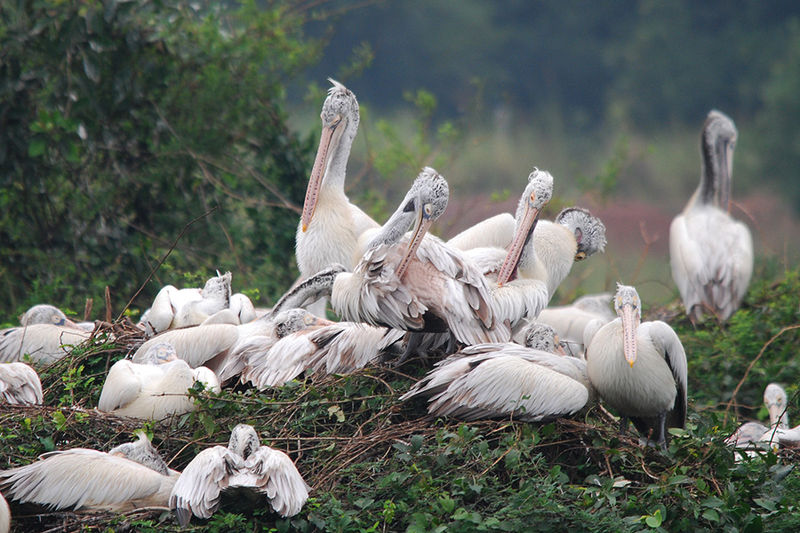The Nellore region, nestled in Andhra Pradesh, India, becomes a vibrant hub for avian activity each year as numerous bird species undertake their annual migrations. These seasonal journeys, driven by factors such as breeding, feeding, and escaping harsh winter conditions, bring a spectacular array of feathered visitors to Nellore’s diverse landscapes.
Why Nellore?
Nellore’s geographical location and varied ecosystems make it an attractive destination for migratory birds. The region boasts a coastline with lagoons and backwaters, freshwater lakes, agricultural fields, and patches of scrub forest, providing diverse habitats and ample food resources. The relatively warmer climate during the winter months in the northern latitudes also draws birds seeking refuge.
Key Migratory Species:
Several species regularly grace the skies and wetlands of Nellore during their migratory routes. Some notable examples include:
- Flamingos (Phoenicopterus roseus and Phoenicopterus minor): These elegant pink birds are a spectacular sight, often congregating in large numbers in the Pulicat Lake area, which straddles the border of Andhra Pradesh and Tamil Nadu, with a significant portion falling within the Nellore district. They arrive primarily from their breeding grounds in Gujarat and other parts of India to feed on the rich algae and crustaceans found in the brackish waters.
- Pelicans (Pelecanus philippensis and Pelecanus crispus): Both Spot-billed and Dalmatian Pelicans can be observed in Nellore’s wetlands. They are drawn to the abundant fish populations in lakes and reservoirs. The Nelapattu Bird Sanctuary, located in the Nellore district, is a significant breeding ground for Spot-billed Pelicans and also hosts migratory pelicans.
- Storks (various species including Mycteria leucocephala and Anastomus oscitans): Painted Storks and Asian Openbills are frequently seen in and around water bodies in Nellore. They forage in shallow waters for fish, frogs, and other aquatic creatures.
- Ducks and Waders (various species): Numerous species of ducks, such as Northern Pintails, Garganeys, and Common Teals, along with waders like Sandpipers, Plovers, and Godwits, arrive in Nellore during winter. They utilize the region’s wetlands and agricultural fields for feeding and resting.
- Raptors (various species including Falco tinnunculus and Circus aeruginosus): Birds of prey like Kestrels and Marsh Harriers also migrate to Nellore, preying on small mammals and birds in the open areas.
Important Birding Locations in Nellore:
- Pulicat Lake: This is one of the largest brackish water lagoons in India and a critical habitat for flamingos and various other migratory waterbirds [1].
- Nelapattu Bird Sanctuary: Renowned for its large colony of Spot-billed Pelicans, this sanctuary also attracts other migratory species [2].
- Vedurupattu: A village located near Pulicat Lake, Vedurupattu is known as a nesting site for various migratory birds, including Painted Storks, often found on tamarind trees [3, 4]. It forms an integral part of the larger Pulicat Lake ecosystem.
- Bodilingalapadu and Sriharikota Island: These areas, part of the extensive Pulicat Lake ecosystem, also serve as important locations where migratory birds reside and feed during their stay [4].
- Krishnapatnam Port Wetlands: The area around the Krishnapatnam Port has developed into an important site for migratory waders and other waterbirds.
- Local Tanks and Reservoirs: Numerous smaller water bodies, irrigation tanks, and reservoirs across the Nellore region also provide refuge and feeding grounds for migratory birds, serving as vital temporary habitats.
- Coastal Wetlands: The extensive coastline of Nellore, with its numerous small lagoons, backwaters, and mudflats, provides ample foraging opportunities for shorebirds and other coastal species.
The Flamingo Festival in Nellore:
To celebrate and highlight the ecological importance of these migratory visitors, the Nellore region hosts the vibrant Flamingo Festival annually.
- Purpose and Significance: The festival is a major eco-tourism event designed to raise awareness about the rich biodiversity of Pulicat Lake and Nelapattu Bird Sanctuary, particularly the spectacular arrival of flamingos and other migratory birds. It aims to promote conservation efforts and sustainable tourism practices [5, 6].
- Location: The festival is primarily celebrated across several prominent locations, including Sullurpeta (often the main venue for cultural programs), Nelapattu Bird Sanctuary (for close-up birdwatching), Pulicat Lake (offering guided tours and boat rides), and Tada [4, 5, 6].
- Timing: The Flamingo Festival is an annual event, typically held in January, coinciding with the peak season for migratory bird arrivals, offering the best opportunity for visitors to witness the avian spectacle [5].
- Activities: The festival features a range of activities: birdwatching tours, photography competitions, cultural programs, environmental workshops, and exhibition stalls, all aimed at engaging the public and fostering appreciation for nature [5, 6].
Conservation Efforts:
The influx of migratory birds highlights the ecological importance of the Nellore region. Conservation efforts focused on protecting and maintaining the integrity of these vital habitats are crucial to ensure the continued arrival of these avian visitors. Awareness among local communities and sustainable development practices play a key role in supporting bird conservation. The annual Flamingo Festival also serves as a critical platform for fostering appreciation for nature and advocating for the protection of the Nellore region’s invaluable avian visitors and their habitats.
Conclusion:
The annual bird migrations to the Nellore region are a testament to the interconnectedness of ecosystems across continents. The arrival of these diverse avian travelers transforms the landscape and underscores the importance of preserving Nellore’s natural heritage for future generations to witness this spectacular natural phenomenon.
Citations:
- Andhra Pradesh Forest Department. “Pulicat Lake Bird Sanctuary.” (Insert relevant link if available).
- Andhra Pradesh Forest Department. “Nelapattu Bird Sanctuary.” (Insert relevant link if available).
- Kalpavriksh. “Nellapattu & Vedurapattu Villages.” https://kalpavriksh.org/nellapattu-vedurapattu-villages/ (Accessed July 28, 2025).
- India Tours. “Pulicat Lake Bird Sanctuary.” https://www.india-tours.com/wildlife/pulicat-lake-bird-sanctuary (Accessed July 28, 2025).
- Adda247. “Flamingo Festival 2025 Concludes in Andhra Pradesh.” https://currentaffairs.adda247.com/flamingo-festival-2025-concludes-in-andhra-pradesh/ (Accessed July 28, 2025).
- Utsav.gov.in. “Flemingo Festival.” https://utsav.gov.in/view-event/flemingo-festival (Accessed July 28, 2025).
Disclosure: This article has been written and edited with help from Google Gemini.
